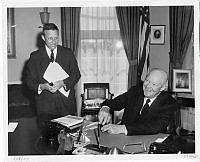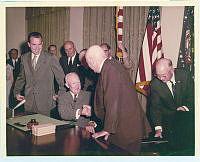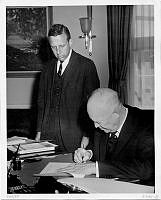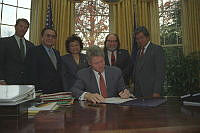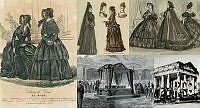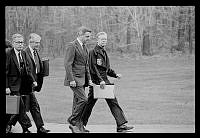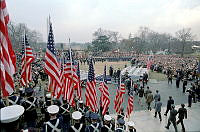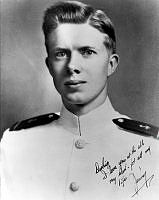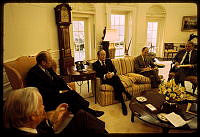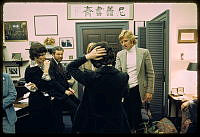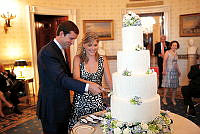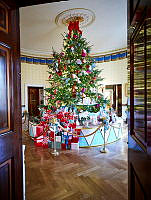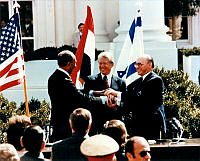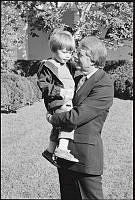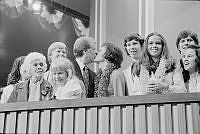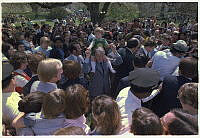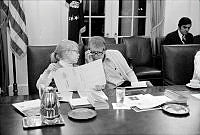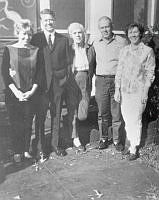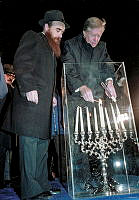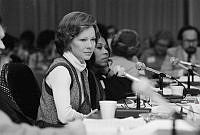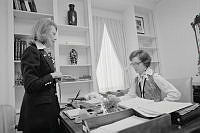President Buchanan Greets a Guest of State
The Prince of Wales at the White House
Copyright © White House Historical Association. All rights reserved under international copyright conventions. No part of this article may be reproduced or utilized in any form or by any means, electronic or mechanical, including photocopying, recording, or by any information storage and retrieval system, without permission in writing from the publisher. Requests for reprint permissions should be addressed to books@whha.org
By the fall of 1860, the Buchanan administration seemed headed for a tense but dramatic conclusion. Earlier that year, President James Buchanan had pointedly declined the renomination, exhausted by a fractured relationship with Congress and last minute attempts to quash talk of southern states’ secession from the union. He believed that his best efforts at reconciliation between states’ rights activists and abolitionists had been thwarted at every turn. The “spirit of discontent”1 that wracked the nation remained a dark cloud looming over the final months of Buchanan’s term of office. He was resigned to leave the White House with a heavy and burdened heart, and Republican presidential candidate Abraham Lincoln was elected on November 6, 1860, to take the reins of a nation on the brink of a civil war. In this atmosphere, the visit of Albert Edward, Prince of Wales, must have been welcomed as a much-needed, albeit brief, diversion. In the first visit of British royalty to the United States, Buchanan saw an opportunity for his citizens to participate in a historic event that could temporarily unite them. Surely he hoped the excitement generated by the prince’s visit would bring the nation’s angst to a momentary halt.
As heir to the British throne, the Prince of Wales was highly revered and honored in the United States as well as Britain. With multiple royal titles, lavish estate holdings, servants, and private tutors, Prince Albert Edward, later King Edward VII, seemed destined to ascend to the throne as a successful and accomplished leader. Yet, throughout his life, the prince was a source of disappointment to both his parents. In his youth, Albert Edward demonstrated a predisposition to fine food and wine, sporting activities, hunting, and womanizing, and he fought against the strict and regimented lifestyle that he found foisted upon him. While Queen Victoria desperately tried to shape her eldest son in the image of his peerless father, Albert Edward repeatedly rebuked her best efforts, displaying only a languid and enervated spirit. The Prince Consort remarked sadly in a letter to his daughter Princess Frederick William, “Bertie’s propensity is indescribable laziness. I never in my life met such a thorough and cunning lazybones ... it does grieve me when it is my own son, and when one considers that he might be called upon at any moment to take over the reins of government in a country where the sun never sets.”2

The route taken by the Prince of Wales on his 1860 North American tour.
Library of CongressAs a young man of 18, the Prince of Wales could have been likened to most other teenagers—independent, rebellious, and strong willed. And, because of his youth and disposition, he had not yet been given the opportunity to distinguish himself in service to his country. It was hoped that the trip to North America would mark the beginning of his formal indoctrination into the responsibilities and duties of a member of the British royal family. As the prince knew little of affairs of state, his traveling party was chosen with the greatest care and included some of the most decorated and respected individuals in English society. The Duke of Newcastle, a distinguished statesman, was personally selected by Queen Victoria for Albert Edward’s chief adviser and, as such, was held responsible for the youth’s conduct throughout the tour. The “Governor” to the prince, Major General Bruce, and Earl St. Germains, the Lord High Steward of Her Majesty’s household, were also selected to make the journey. The entourage was supplemented by Dr. Henry Acland, the prince’s physician, and various equerries, including Major Teesdale and Captain Gray. Lord Lyons, the British minister for the United States, was to meet the prince and his party upon their arrival in North America.

An 1860 cartoon portrays the young Prince of Wales preparing to relate the details of his American travels to his father, the Prince Consort.
Library of CongressQueen Victoria’s original intention was to dispatch her son simply to visit England’s western possessions in Canada and inaugurate the opening of the Victoria Bridge in Montreal. Yet, upon receipt of a letter from President Buchanan, the queen was pleased to extend the prince’s visit to the United States. Both Buchanan’s letter to the queen and her positive reply were printed in American newspapers, and their words illustrate the strong, personal bond felt between the two rulers. On June 4, 1860, President Buchanan wrote: “I need not say how happy I should be to give him [the Prince of Wales] a cordial welcome to Washington. You may well be assured that everywhere in this country he will be greeted by the American people in such a manner as cannot fail to prove gratifying to Your Majesty.” In a similar style, the queen replied that the prince would, with great pleasure, be received at the White House. “He will thus be able, at the same time, to mark the respect which he entertains for the Chief Magistrate of a great and friendly State and kindred nation.”3 The queen indicated that Prince Albert Edward would drop all royal title and travel officially incognito under the name of his lowest-held English title, Baron Renfrew. In this decision, she simultaneously gave the prince a veil of safety under which to travel and demonstrated proper deference to President Buchanan’s elected position.
The tone of familiarity marking the correspondence between these two rulers dates to James Buchanan’s position as minister to England under President Franklin Pierce, from 1853 to 1856. While living in London, Buchanan, accompanied by his niece Harriet Lane, was often warmly entertained by the queen and the royal family at Buckingham Palace. Miss Lane once wrote to her sister, Mary Baker, that “Her Majesty [Queen Victoria] was very gracious ... as also was the Prince.”4 Friendships ensued, and President Buchanan and Miss Lane were fortunate to retain strong bonds with the queen upon their return to the United States.
The prince’s party set sail from Plymouth in July 1860. During the next three months, he made countless diplomatic appearances. By the time he reached Baltimore on his approach to the capital city of Washington in October, he had already been greeted in seven American cities. Yet his welcome in Baltimore was especially exuberant. As a brass band played “God Save the Queen,” the prince momentarily stepped from his railcar and was greeted by the mayor of the city and the British consul. “Thousands followed behind and alongside, cheering and waving hats, caps, and newspapers; while ladies, with fluttering pocket- handkerchiefs, eyed the great hero of the day with delight.”5 After a short train ride from Baltimore, the prince and his traveling companions arrived in Washington at 4:00 in the afternoon of October 3, 1860. The president’s nephews, Henry and Buchanan, and Secretary of State Lewis Cass were eagerly waiting to receive the prince and convey him to the White House, where he was officially presented to the president and Miss Lane.
Although a formal state dinner was planned for the next evening, an elaborate dinner was given that first night. Thirty-five guests attended, many of them cabinet officers and their wives. By way of honoring both the president and the prince, the Marine Band played the national music of Great Britain and the United States during dinner. While most of the entourage was housed at the British Embassy, the Prince of Wales, Duke of Newcastle, Lord St. Germains, Dr. Acland, and General Bruce stayed at the White House as guests of the president. Oddly, there are varying reports as to which room the prince occupied. Some indicate that the president of the United States gave up his own quarters to provide proper sleeping accommodations for the prince. Yet correspondence between May S. Kennedy, a Buchanan descendant, and Abby Gunn Baker, a Washington journalist, cites a memorandum written later by Harriet Lane Johnston stating that the “Prince did not occupy one of the south rooms, but the north room over the small dining room; the adjoining room on the north west corner being his dressing room.”6 Assuming this account is correct, the president did not vacate his bedroom and the prince retired in what is now the second floor dining room. Similarly, the room which was used for the prince’s dressing room is currently the private kitchen on the second floor of the residence. John Engleheart, private secretary to the Duke of Newcastle, later remarked on his experience in the President’s House: “The White House is an imposing structure, and commands an extensive view from the back over the Potomac—the shaft of what will be a gigantic column in memory of Washington is slowly rising just beyond the grounds.”7

The Prince of Wales (standing center, with cane and top hat) posed with his entourage in Mathew Brady's New York studio in October 1860.
Library of CongressThe next morning, October 4, under the mayor of Washington’s guidance, the prince and his companions visited the Capitol at 10:30 a.m. Following this outing, a large public reception was given in honor of the prince in the East Room of the White House. A New York newspaper correspondent most clearly described the scene:
The morning papers announced a Presidential reception for twelve o’clock. Long before that hour a motley crowd assembled before closed doors. Shortly before noon the doors opened, and the rush began. Mr. Buchanan, the Prince, Lord Lyons, the Duke of Newcastle, Earl S. Germains and General Bruce stood in that order at the back of the East Room. Into that room hurried pell-mell, in a disorderly and mobbish manner, ladies, gentlemen, officers, workmen, children, nurses, rowdies, and drivers. No telegraphic statement can do justice to the inexcusable lack of prearrangement for the preservation of decency, not to speak of order. The Royal party have certainly seen Democracy unshackled for once. All bowed to the Prince, and the Prince returned their salutations. The President shook hands with everybody and hurried them along as quickly as possible.8
According to this report, it certainly seems that enthusiasm for the prince’s visit ran rampant among all Americans, regardless of their station or social status, and a further newspaper asserted its belief that the prince was able to “form a good idea of the character of our Presidential receptions, their freedom from stilted etiquette, and the perfect equality which ignores social distinctions.”9 Acting as first lady, Harriet Lane had scheduled various appointments for the prince, and later that afternoon both Miss Lane and Mrs. Jacob Thompson, the secretary of the interior’s wife, accompanied him to the gymnasium of a girls’ school to play a game of tenpins.
The state dinner, set for 32 guests, ended with an elaborate display of fireworks. Like the more recent display of fireworks to celebrate the state visit of President Vicente Fox of Mexico in September 2001, the 1860 spectacle was arranged to honor both the host and visiting nation. In the case of the prince’s visit, the fireworks were a “combination of American and English symbols. The centre was composed of Columbia and Britannia with American and English coats-of-arms. Above them was a large globe with American and English flags, a large steamship, etc.—160 feet long, 50 feet high—said to be the largest piece of fireworks ever made. The piece was surrounded by bombs that sent up showers of stars.”10

The October 20, 1860, cover of Harper's Weekly carried three scenes from the American travels of the Prince of Wales: the game of tenpins in Washington, D.C., the dance floor collapsing in New York, and the welcoming crowd of his admirers in Boston.
Library of CongressThe final event the prince attended in Washington was a much-anticipated visit to Mount Vernon. Although the president had decreed that “the press is to be suppressed on this occasion,"11 there is rich evidence of the events of this day. President Buchanan, the Prince of Wales, and their respective parties traveled to Mount Vernon via the Revenue Marine Cutter Harriet Lane, used as a presidential yacht, and aptly named. Once aground, the group was taken on a tour of the house and grounds by Janet Riggs, vice regent of the District of Columbia. At Washington’s gravesite there was a solemn ceremony in which the prince planted a horse chestnut tree to commemorate the historic event. The Marine Band played a funeral dirge that was composed for the occasion by their director, Francis Scala, who derived it from the Italian opera, II Trovatore. It was certainly noted and appreciated by the president’s delegation that the great-grandson of George III paid respect to the memory of a great American statesman. The sombemess at the tomb was quickly followed, however, by a festive atmosphere aboard the boat during the return to Washington.
The prince often corresponded with his mother, Queen Victoria, during his travels through North America, and his letters, signed simply “Bertie,” provide further description and insight into the prince’s experiences in Washington:
The President and his niece Miss Lane received us very kindly on arriving, and I did not fail to give the messages which you desired. There was a large dinner at 6:30 at which all the Ministers and their wives, and some others were invited. The President was looking very well, but has grown much stouter. I thought Miss Lane a particularly nice person, and very pretty. The President’s house is a very nice one, and the rooms are really very fine, and comfortably furnished. Washington is a fine looking town and contains some striking buildings. The finest is the Capitol, in which Congress sits, and we visited it the day after our arrival. I shall bring home some drawings of it which will give you a much better idea of it than if I explained it now. We visited also the same day the Patent Office which is the same thing very nearly as the United Service Museum in London, and contains models of different inventions. All the Public Offices are in the same building, and we might easily take some hints for our own buildings which are so very bad.

The White House reception given for the Prince of Wales is illustrated in this wood engraving, which appeared in the October 20, 1860 issue of Frank Leslie's Illustrated Newspaper. The prince is seen bowing to guests in the center of the East Room; President Buchanan stands to his right.
White House Collection/White House Historical AssociationHis next letter recorded:
Mount Vernon is a much revered spot by the Americans, as the House in which General Washington lived and also died stands there. The visit therefore was a very interesting one; the house itself is unfortunately in very bad repair and is rapidly falling into decay; we saw all the different rooms and the one in which Washington died. We also visited his grave which is a short distance from the house, and by the wish of the President I planted a Chestnut [tree] near it.12
Following the prince’s departure from Washington, the president again was obliged to correspond with the queen. Buchanan’s October 6, 1860, letter indicated that he found Albert Edward to be “dignified, frank, and affable” and included the following sentiments: “In our domestic circle he has won all hearts. His free and ingenuous intercourse with myself evinced both a kind heart and good understanding. I shall ever cherish the warmest wishes for his welfare. The visit of the Prince to the tomb of Washington and the simple but solemn ceremonies at this consecrated spot will become an historic event and cannot fail to exert a happy influence on the kindred people of the two countries.” Using complementary language and signing the letter “always your good friend,” Queen Victoria made a warm reply that documented both her personal fondness and political savvy: “I am impelled to express . . . how deeply 1 have been touched by the many demonstrations of affection . . . which his [the Prince of Wales’s] presence has called forth. I fully reciprocate towards your nation the feelings thus made apparent and look upon them as forming an important link to cement two nations of kindred origin and character.”13
These personal messages written by President Buchanan, Queen Victoria, and the Prince of Wales contain valuable descriptive evidence of the historical events and emotions surrounding Prince Albert Edward’s unprecedented tour. Yet, while these letters indicate the prince had successfully discharged his formal duties in Washington, the American public had not finished bestowing lavish attention on him. At the end of his stay in the capital city, the prince again boarded the Harriet Lane and began the final segment of his journey. Adhering to a prearranged itinerary, he and his entourage toured numerous American landmarks and visited several northern cities, notably Philadelphia, Boston, and New York.

In an 1861 sketch captioned, "The son of the Queen had come over the wave, And planted a tree upon Washington's grave," which pictures George Washington's spirit witnessing the planting of a chestnut tree.
Library of CongressThe Philadelphia visit passed without much ceremonial fanfare; the prince toured a local penitentiary and an insane asylum and was taken to a horse race and a performance at the Philadelphia Opera House. In Boston, the prince, accompanied by Ralph Waldo Emerson, Oliver Wendell Holmes, and Henry Wadsw'orth Longfellow, was honored w ith a formal reception and an excursion outside the city to visit Harvard University. The most splendid and glamorous of the American events in his honor, however, took place in New York, where the crowds were also the most admiring and enthusiastic. Upon being received by New York City Mayor Fernando Wood, the prince found himself “immersed in public activities,”14 including a formal review' of the troops of the Seventh Regiment under the command of General Charles W. Sandford. Later, when the prince’s procession attempted to pass through the streets to his hotel, massive, cheering crowds jockeyed to glimpse the first royal visitor on American soil. The Duke of Newcastle later compared the crowd’s enthusiasm to “madness” when he described the scene to Queen Victoria, and the popular humorist Major Jack Downing declared, “He [the Prince of Wales] may consider himself a lucky lad if he escapes a nomination for President before he reaches his homeward-bound Fleet.”15
Still, the zealous crowds on Broadway were eclipsed by the magnificent ball that was given in honor of the prince at the Academy of Music by 400 of New York’s most prestigious and wealthy citizens. Only friends and family of the hosts had access to the scant 3,000 tickets, and while the exclusivity of the event drew criticism, the exquisite fashions and extravagant jewelry of the guests were unparalleled. The spectacular decor and floral displays transformed the Academy of Music into a breathtaking sight to behold.
Yet, the evening did not proceed without incident. Those who did not have tickets attempted to force their way into the event, and the size of the ballroom could barely sustain the capacity. A temporary floor had been built. Upon his arrival at the ball,
the Prince found the whole of the area somewhat densely packed, the boxes and lower galleries full. The company had already begun to pass before him, bowing as they passed, when some cracks, followed by a few screams, were heard proceeding from the centre of the mass, which suddenly separated in all directions, leaving a few ladies and gentlemen to extricate themselves. . . . The [temporary] floor had given way, and, though no great injury was done to aught save crinoline, the accident delayed the opening of the ball for two hours. The Prince and his party proceeded to the supper room, while the carpenters took possession of the floor of the theatre and commenced its repair, and, as the story goes, were so intent on the operation that they inadvertently nailed down one of their fellows; a plank having to be taken up before he could be released.16
Dancing was not able to begin until midnight, and although the prince described the ballroom as a ‘Very pretty sight,” he succinctly dubbed the evening “not successful.” In the prince’s last night in New York he witnessed an impressive sight: more than 6,000 uniformed firemen parading down Fifth Avenue carrying lighted torches, Roman candles, and blue and red lights in commemoration of his historic visit. Prince Albert Edward and his party watched from their hotel balcony.
The prince’s North American tour was an unqualified achievement and proved to be a landmark in the young man’s career. To his parents, the Duke of Newcastle and General Bruce acknowledged “the development of mind and habit of thought” that the prince had acquired upon the long journey.17
For the United States, the prince’s visit provided both the president and the populace a brief respite from the dilemmas confronting them. The prince had captured the attention of a nation poised on the edge of disaster and given its people an excuse to celebrate. Traveling approximately 2,700 miles on American soil, the prince left an indelible mark on a democratic country that had gained a newfound respect for its British counterpart.













